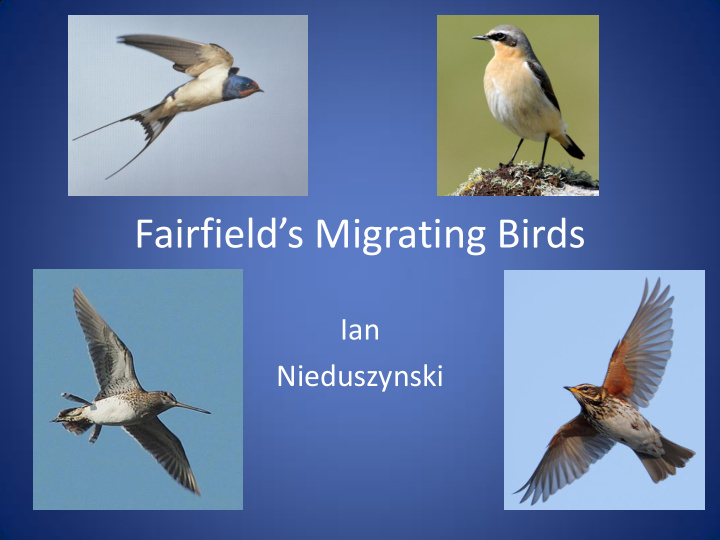



Fairfield’s Migrating Birds Ian Nieduszynski
Why Migrate? Bird migration is a regular seasonal movement between breeding and wintering grounds, undertaken by many species of birds. Migration, which carries high costs in predation and mortality, is driven primarily by availability of food.
Why Britain?
Why Fairfield? • Warmer western location • Coastal • Lowland Habitats include:- • Wetland • Arable • Woodland/Hedgerows January Isotherm Our Management for Wildlife
Fat the Fuel for Migration Fats are 9 times more efficient fuels than carbohydrates and produce 9 kcal per gram. Each gram of fat also produces one gram of water for the bird. Finally, small birds may double or triple their weight, but a large bird like a swan may only add 12% to their weight.
Monitoring Trends in Bird Populations British birds are assigned to:- Red, Amber or Green lists A criterion used in assigning birds to the red list is severe (at least 50%) decline in breeding population or contraction of breeding range over last 25 years.
WINTER MIGRANTS
Whooper Swans These swans migrate 900-1200 km from Iceland. They are our largest migrant (11 kg) and this journey is near the limit of their range. They may be seen on Aldcliffe marsh in winter.
Flight Range Large Small birds birds Here we see flight range as a function of how much a bird can bulk up. This is just like a plane taking on fuel!
Pink-footed Goose The pink-footed goose is medium-sized and migrates here from Iceland and Greenland. ~360,000 birds winter in Britain.
Blackcaps We generally think of blackcaps as spring visitors, with > 2 million birds arriving in March or April. They are handsome warblers with a beautiful song. But, let us look at the cohort of winter migrants ( yellow arrow).
Blackcaps Normally insectivorous, blackcaps switch to a diet of berries prior to migration and gorge themselves, increasing their weight from 20 to 31g.
Blackcaps In the past, all German blackcaps have migrated SW wards in September towards Spain. Since the 1960s, some German blackcaps have been migrating to Britain. These birds depend on our garden feeders, and are now reproductively isolated from those following the traditional route.
Snipe Breeding - 160,000 birds. Wintering – 1.1 million birds. Snipe are medium sized (100g), wading birds with long straight bills. They have the longest bill relative to body size of any bird in Britain. They feed on small invertebrates, including worms and insect larvae.
Snipe numbers are a classic example of the impact of land drainage upon farmland since the 1970’s.
Snipe Distribution Breeding Winter
Migration British breeding Snipe are short- to medium-haul migrants. Autumn migration begins in August. In winter, our birds are fivefold outnumbered by migrants from Iceland and Fennoscandia, which start to arrive in September.
We have up to 150 snipe in winter
The Secretive Waders Woodcock >300g Common Snipe 100g Jack Snipe 50g
Scandinavian Thrushes - Fieldfare These are thrushes of Scandinavian and Russian origin. They are social birds, spending the winter in flocks of, from a dozen or two, to several hundred strong. They are often seen in winter in west field.
ScandinavianThrushes - Redwing These thrushes eat berries and fruit as well as worms. They are often seen in mixed groups with fieldfare. When winter weather is severe they conflict with mistle thrush residents, defending a well-berried tree.
Linnet Linnets are small, slim finches with a characteristic undulating (bouncy) flight. They tend to be an upland bird but can be seen in large flocks in winter in Fairfield (along the Pads path and on the oak and hawthorn trees).
SUMMER MIGRANTS
Swallow Migration of swallows between Britain and South Africa was first established in1912 when a bird that had been ringed at a nest in Staffordshire, was found in Natal.
Swallow Migration Migrating swallows cover 200 miles a day, mainly during daylight, at speeds of ~20 miles per hour. The maximum flight speed is 35 mph. • 50% of adults don’t return • 80% of juveniles don’t return Distance travelled ~5500 miles ~9000 km.
Chiffchaff & Willow Warbler These are leaf warblers. Chiffchaffs have a simple call, but willow warblers have a proper song, a descending trill.
Sahara 4800 km/ 3000 m West to East 1800 km/ 1100 m North to South Our summer migrants face the challenge of this crossing and fly by night and rest up during the day. Flying north by night at 2 – 4 km high, temperatures are 10 degrees C.
Passage Migrants
Wheatear Wheatears (Anglo-Saxon – White-arse ) are insect eating birds that migrate to the UK from the Western Sahel, south of the Sahara. They arrive in two waves. Birds that breed in Britain arrive in early March, but another group which we see in our arable field arrive in mid- to late-April where they fatten up to migrate further to Greenland and Canada.
This is a 15,000 km Africa - 5 months journey, with a 3500 km Canada - 3 months Travelling – 4 months Atlantic crossing.
Refuelling in Fairfield From Fairfield blog entries:- 2013 18 April 2014 25 April 2015 23 April 2016 6 and 14 April 2017 15 April
Where are “OUR” birds ?
THE END
Proximity to Extinction An international criterion is proximity to extinction.
Recommend
More recommend